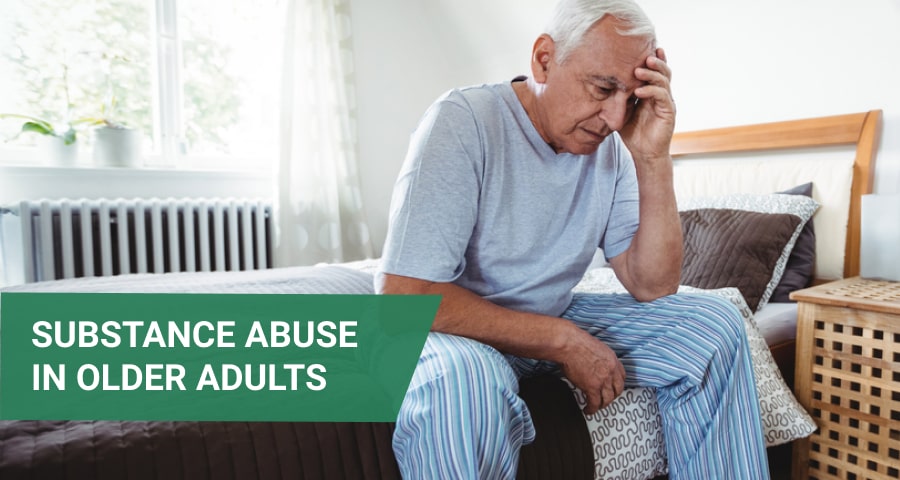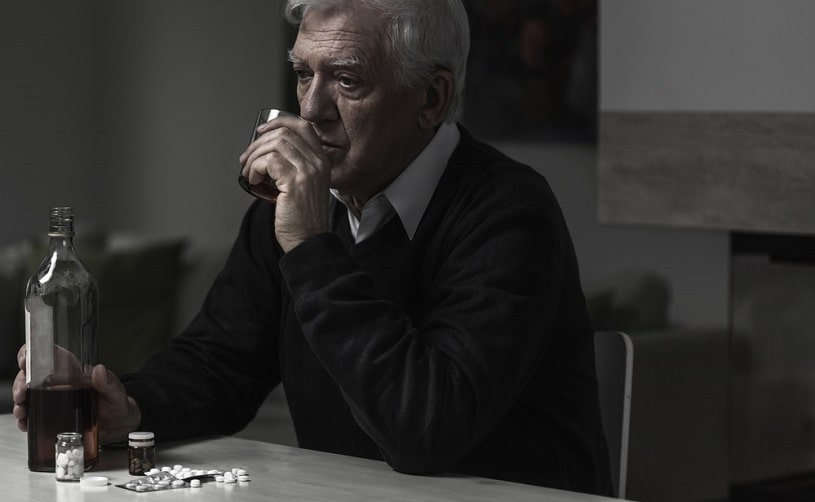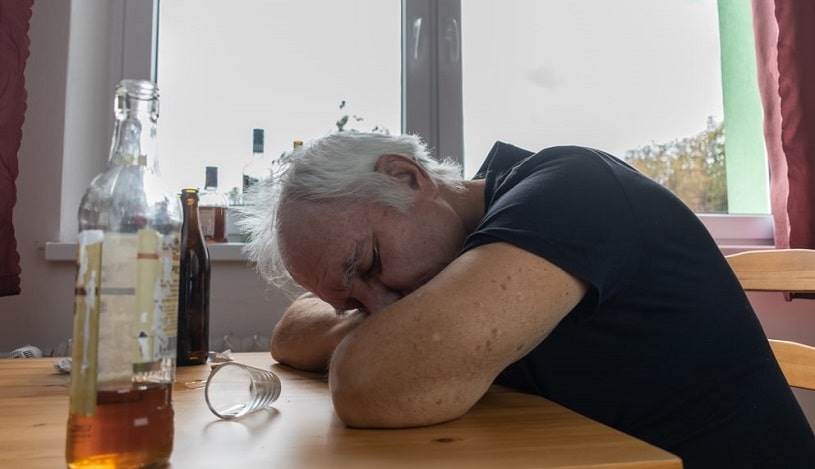
Older adults have not demonstrated high rates of drug or alcohol use over time compared with younger adults. It has contributed to a misconception that seniors do not abuse alcohol or drugs, and there is no such problem as alcoholism in the elderly. An ever-growing body of evidence suggests that substance abuse in older adults has gone unnoticed for decades. The baby boom generation, which is currently in its 60s, faces some frighteningly real risks.
Table Of Contents:
Elderly Drug Abuse: The Facts
Drug and alcohol abuse is harmful to health at any age, but never more so than in seniors. The impact of alcohol-related injuries is much more severe, the general physical effects of drugs and alcohol are more serious, and dangerous medical interactions are a distinct and scary possibility.
Below Are Some Facts Provided by the National Institute on Drug Abuse:
- 1 million adults age 65 and older suffer from a substance abuse problem
- Between 2013-2015 the number of older adults using heroin doubled
- 65% of older adults report risky alcohol consumption, 10% report binge drinking
- Up to 11% of hospital admissions of older adults are due to alcohol or drug problems
- Older adults are hospitalized as often for heart attacks as for alcohol-related issues
- Seniors get almost 17 million prescriptions a year for tranquilizers, the most abused drugs
Why Do Seniors Abuse Drugs and Alcohol?
Older people turn to drugs or alcohol for many reasons. First, they retire and need to downsize to a smaller home. There’s the sheer boredom of retirement. Their children leave. Friends pass away. Physical and mental health suffers. A spouse of many years gets ill or dies. Apart from these, there are four main reasons for elder substance abuse: by accident, because of tolerant attitudes, mental health issues, and because they are being abused.
- By Accident. Most seniors who abuse prescription medications do so unwillingly. After all, they do take more medications than any other age group. According to data from the Substance Abuse and Mental Health Services Administration (SAMHSA), 33% of people between the ages of 57 and 85 use five prescriptions on average. It leads to a very real risk of mistakes. What is more, the number of people over 65 taking four or more prescription drugs at once rose from about 33% in 1988 to almost 50% in 2000.
- Tolerance. The baby boomer generation has always been tolerant toward alcohol and drug use, and a large part of the population has a history of using illegal and illicit drugs. Americans born in 1960 broke the record for frequency of illicit drug use; data of the national Monitoring the Future survey show – up to 80% of those surveyed admitted taking drugs. An investigation by the Wall Street Journal revealed that many of them stopped doing drugs as they entered adulthood but started again after experiencing some trauma in their life, such as job loss, divorce, or loss of a loved one. Other boomers never stopped using.
- Mental Illness. The coexistence of elderly addiction and mental illness has been established in several studies, with prevalence estimated at 44% on average, according to a survey by Bartels published in the Journal of Dual Diagnoses. Every fourth elderly patient abusing drugs or alcohol suffers from comorbid depression. Anxiety disorders and cognitive disorders are common as well. They both occur in 10% to 15% of seniors who abuse drugs.
- Abuse. According to WHO, about 15% of seniors are abused every year. Most cases are not reported. Every year, an estimated 2.1 million older adults are victims of psychological, physical, or other forms of abuse. That’s one victim every few seconds. The connection with elderly addiction to drugs and alcohol is undeniable. In 80% of the reported cases, the perpetrator is a close relative, making the person even more vulnerable.
Early- and Late-Onset Alcoholism & Addiction
According to the Office of Alcoholism and Substance Abuse Services, older persons with a substance use problem can be classified based on two general categories: early- and late-onset addiction. The former refers to people who have been abusing drugs or alcohol for many years and are over 65, while the latter develop addictions later in life.
Early-Onset Addiction
A study by Van Citters and Brockmann, published in the Journal of Dual Diagnoses, showed that early-onset abusers (where the abuse started before they turned 65) tend to have many more mental and physical problems that require treatment than their late-onset counterparts.

Early-onset substance abusers make up 66% of cases of elderly alcohol abuse. The reasons for this type of addiction involve tolerant attitudes toward substance use, family conflict, and financial troubles. It is also more common among seniors without college degrees.
Late-Onset Addiction
Potential triggers for late-onset alcoholism and drug abuse (which developed after 65) include retirement, loss of income, death of a loved one, placement in a nursing home or relocation in general, trouble sleeping, and health decline. The most common health problems contributing to late-onset alcoholism are depression, major surgeries, and memory loss. Typically, late-onset abusers experience fewer physical and emotional health problems than early-onset ones. According to a study by Moos published in the Journal of Alcohol Health, they comprise 25% of all elderly patients with a substance abuse problem.
Most Commonly Abused Substances
Alcohol is the substance most commonly abused by seniors. Prescription drugs, more specifically opioids and benzodiazepines, come in a close second. Read on to find out about the reasons and signs of abuse.
Alcoholism in the Elderly
Increasing rates of prescription and illicit drug misuse among seniors notwithstanding, alcohol remains the substance most commonly used and abused by adults over 65. 1.2% of individuals in this age group fulfill the criteria for alcohol use disorder according to the Diagnostic and Statistical Manual of Mental Disorders (Fourth Edition), and 0.24% for alcohol addiction. The prevalence of alcoholism in the elderly is estimated at 2.98%.
Rates of alcohol use disorder reach 22% within health care settings. However, it is believed these rates are higher because many cases of heavy drinking remain unreported, a large number of comorbid disorders are unidentified, and there are challenges to differential diagnoses of alcohol use disorders in older adults.

According to statistics from the 2005–2006 National Survey on Drug Use and Health, prevalence rates for risky alcohol consumption (more than seven drinks per week or more than three drinks in one sitting) are approximately 10.9% for women and 16.0% for men. In addition, many older adults have binge drinking issues (five or more standard drinks in one sitting). Almost 20% of men and just over 6% of women in this age group are binge drinkers.
Signs of Alcohol Abuse in Seniors
How to recognize alcoholism in the elderly? Unfortunately, there’s no 100% way to be sure, but there are signs a loved one may be abusing that one can look out for. These include secretive or solitary drinking, drinking rituals (before, after, or during dinner), loss of interest in things the person enjoyed doing earlier, and consuming alcohol despite labels on prescription drugs warning about a possible interaction.
Of course, slurred speech, smelling of alcohol, and change in physical appearance are all signs that a person needs help and treatment. Common symptoms include chronic, medically unfounded health complaints, confusion, hostility, memory loss, and depression.
Prescription Drug Abuse
Seniors take more prescription medications than younger adults, increasing the risk of misuse and harmful interactions. A community-based cross-sectional study of 3005 persons between the ages of 57 and 85 found that 36% of women and 37.1% of men used at least five prescription drugs concurrently. The study also showed that about 1 in 25 of those surveyed faced a high risk of a drug interaction.
Research by Blazer and Wu carried out for the National Institutes of Health found that 2.9 million adults over 50 years of age used opioids non-medically in 2012. The use of benzodiazepines, the most commonly prescribed psychiatric drugs, ranged from 15.2% to 32.0% in persons over 65 that year. Rates of benzodiazepine use are shown to be impacted by misdiagnosis, over-prescription, and misdosing.
If an older person takes multiple medications, they can misdose by accident. It can also happen due to cognitive decline, which is a normal part of aging, or disregard for warning labels.
It can be challenging for seniors to remember when and how much of each of their medications to take, especially when their minds are fuzzy and they take multiple drugs for relatively long periods.
Moreover, they can unknowingly become addicted to these medications, making it another cause of substance abuse in the elderly.
Symptoms of Prescription Drug Abuse in Seniors
There are four types of symptoms of prescription drug misuse and abuse in seniors: cognitive, social, physical, and psychiatric.
- Cognitive Symptoms. The main cognitive symptoms of drug abuse include disorientation and memory loss. These can go unnoticed because they are typical of old age. A more apparent sign involves recent decision-making difficulties, which could be evident to family members. Overall cognitive impairment may be present as well.
- Social Symptoms. These symptoms of elder substance abuse can include sudden social isolation, family, legal, or financial troubles, or forms of behavior such as borrowing medication from others, getting a prescription for the same drug from two or more doctors, filling a prescription for the same drug at two or more pharmacies, and arbitrarily increasing the frequency or amount of their dose. The patient may then start running out of medication early.
- Physical Symptoms. Prescription drug abuse’s most common physical symptoms are poor hygiene, incontinence, impaired self-care, increased tolerance or unusual response to medicine, dizziness, poor nutrition, sensory deficits, idiopathic seizures, blackouts, and chronic pain complaints.
- Psychiatric Symptoms. Finally, this group includes insomnia and other sleep disturbances, anxiety, rapid mood swings, and depression. They may become angrier or more withdrawn or appear forgetful and confused. They will often talk about a drug and be afraid to go anywhere without it.
- Other Symptoms. If a senior gets defensive when one asks them about medicine, this could be a sign of abuse. In addition, they will make excuses for why they need the drug, store extra pills on their body or around their home, and hide or sneak medicine. If a loved one has been treated for prescription drug or alcohol abuse in the past, you need to be particularly vigilant.
Dangers Of Substance Abuse in Older Adults
The elderly are more vulnerable to the damaging effects of drugs and alcohol. Elderly drug abuse is more dangerous than in any other age group. It can lead to rapid deterioration of health or prove fatal.
The Impact of Alcohol
As a person ages, total body water and lean body mass decrease. The liver processes alcohol more slowly, and brain neuronal receptor sensitivity to alcohol and blood-brain barrier permeability increase. As a result, the elderly have higher blood alcohol concentrations than younger adults, suffer more significant impairment, and are less aware of it. Alcoholism in the elderly is more likely to cause functional impairment, compromising their ability to perform everyday tasks such as shopping, cleaning, and cooking.

According to a study by Moore and Endo, the results of which were published in the Journal of the American Geriatric Society, the higher rate of comorbid physical and psychiatric conditions and the prescription medications used to treat them render older adults extremely vulnerable to the impact of alcohol.
The Impact of Prescription Drugs
The same biologic changes that exacerbate the effect of alcohol among seniors also enhance the effects of prescription drugs. Seniors process benzodiazepines and opiates differently than younger people. Benzodiazepines such as tranquilizers with long half-lives can cause excessive sedation in older adults. These drugs act on their bodies longer because they have less lean muscle mass and more body fat. Other risks associated with elderly drug abuse and prescription medication misuse can manifest because they may see many doctors, each of whom may prescribe them drugs that interact with alcohol or each other.
Other Risks
Older adults and seniors who abuse alcohol or prescription drugs face a higher risk of developing illnesses like osteoporosis, ulcers, diabetes II, irritable colon, varicose veins, conditions of the small or large intestine, and chronic bladder inflammation. These are not to be underestimated, as they can progress swiftly at this age. In particular, irritable colon and bladder inflammation have been linked to colon cancer in persons over 60. In addition, elder substance abuse causes an increased risk of household-related accidents, like falls, bone fractures, and burns.
Misdiagnosis and Lack of Treatment
Drug or alcohol abuse may mimic symptoms of other physical or psychiatric disorders, such as diabetes, Alzheimer’s, or depression. Quite a few doctors have chalked signs of addiction up to “old age.”
An already mentioned study of 400 primary care physicians shows how unlikely it is for older adults to be screened for drug or alcohol abuse. The doctors were given a list of symptoms related to problematic drug use by a hypothetical senior. Just 1% of primary care physicians take the possibility of substance abuse in older adults into account.
Among the factors preventing screening and subsequent identification of risky substance use are social stigmas related to and the inconvenience of assessing for addiction, the fact that clinicians have too little time to screen for more than one potential issue or illness, and the similarities of the substance abuse symptoms to other diseases common in late adulthood.
Finally, seniors have trouble identifying risky behaviors surrounding alcohol and prescription drug use, making it even harder to establish that such behavior is occurring.
Irrelevance of DSM Criteria
Physicians rely on the criteria outlined by the DSM to diagnose substance abuse disorder in the general population. That is perhaps the main reason for misdiagnosis and lack of treatment of seniors – these criteria are less relevant to them.
Increased vs. Reduced Tolerance
One criterion in the DSM is increased tolerance toward the substance. In fact, most seniors experience reduced tolerance due to age-related physiologic changes that augment the effects of alcohol and other drugs.
Interruption in Social Roles
Interruption in social and occupation roles or other repercussions of elderly drug abuse may be less noticeable or likely to occur at this stage of life. With age, one departs from these roles naturally in the vast majority of cases, such as through social isolation due to age-group peer mortality or retirement.
Continued Use
The DSM criterion related to continued use of the substance despite recurrent or persistent problems may not apply to many seniors who do not realize that these problems, such as depression, are related to alcohol use or misuse of prescription drugs.
Substance Use-Related Activities
Similarly, another DSM criterion – spending a lot of time on activities necessary to obtain and use a substance or recover from its effects – is irrelevant to older adults. Effects of substance use are evident after consuming relatively small amounts.
Loss of Interest
The DSM criterion related to giving up or reducing important social, recreational, or occupational activities in favor of substance use is similarly inapplicable. Seniors engage in fewer activities regardless of whether substance use is present or not, making it difficult to establish if this criterion is met.
Getting Help for Senior Substance Abuse
Treatment options for elderly alcohol abuse or drug addiction vary depending on the level of medical care needed. They may include educational and preventative services and support, medical detox, and outpatient or inpatient treatment. Admittedly, studies on the effects of treatment of substance abuse in older adults are few and far between, which is why it is crucial to find specific ways to engage the senior.
Taking part in 12-step program meetings such as Alcoholic Anonymous is an important approach to relapse prevention and treatment in general. Meetings with same-age cohorts enable peer bonding, provide mutual support, and help establish peer sobriety networks. Families also play a crucial role in supporting the recovery of their seniors and preventing relapse. Family members should communicate with the elderly in a respectful, empathic way.
Family Communication
Communication should be as clear and straightforward as possible, taking into account age-related brain changes, both normal and abnormal. It is easy to get frustrated with an older person abusing substances, sometimes more so than with one in another age group, because they’re very defensive and set in their ways.

One must recognize this is normal and not give up. Seniors are frequently unaware of the risks they are taking by misusing or abusing psychotropic substances. They may be taking these substances in the same doses or amounts they always did without realizing they now face a higher risk. That is why objective information about the dangers of alcohol or prescription drug use can be helpful.
Helping a Senior Recognize Risk
A senior may not recognize risks even after undergoing some treatment therapy. One can help an elderly parent or grandparent do so by asking if they are taking any medicines that could cause drug interaction and communicating the symptoms of prescription drug misuse or abuse to them. If they are taking several prescription drugs for different health conditions at once, it would be very helpful to write down the doses and administration times in big letters on a sheet and put it up where they will see it, like on the fridge. It is an excellent way to avoid mistakes. Let them know they should always turn to their loved ones and a doctor if they feel like they’ve become dependent on a particular medicine or other substance.
Hope Without Commitment
Find the best treatment options. Call our free and confidential helpline
Most private insurances accepted
Find Drug Rehabilitation Centers Near You Anywhere In the US
Addiction Resource team has compiled an extensive list of the top drug rehabilitation facilities around the country. Use our locator tool to find the best centers near you.
Page Sources
- Bartels, S. J., Blow, F. C., Van Citters, A. D., & Brockmann, L. M. (2006). Dual diagnosis among older adults: Co-occurring substance abuse and psychiatric illness. Journal of Dual Diagnosis, 2(3), 9-30. https://www.tandfonline.com/doi/abs/10.1300/J374v02n03_03
- NIDA, Substance Use in Older Adults DrugFacts, 2020. https://www.drugabuse.gov/publications/substance-use-in-older-adults-drugfacts
- SAMHSA, National Survey on Drug Use and Health (NSDUH). https://www.samhsa.gov/data/data-we-collect/nsduh-national-survey-drug-use-and-health
- Office of Addiction Services and Supports. https://www.oasas.ny.gov/
- Kuerbis, A., Sacco, P., Blazer, D. G., & Moore, A. A. (2014). Substance abuse among older adults. Clinics in geriatric medicine, 30(3), 629-654. https://www.ncbi.nlm.nih.gov/pmc/articles/PMC4146436/
- Qato, D. M., Alexander, G. C., Conti, R. M., Johnson, M., Schumm, P., & Lindau, S. T. (2008). Use of prescription and over-the-counter medications and dietary supplements among older adults in the United States. Jama, 300(24), 2867-2878. https://pubmed.ncbi.nlm.nih.gov/19109115/
- Blazer, D. G., & Wu, L. T. (2009). Nonprescription use of pain relievers by middle‐aged and elderly community‐living adults: National Survey on Drug Use and Health. Journal of the American Geriatrics Society, 57(7), 1252-1257. https://pubmed.ncbi.nlm.nih.gov/19486199/
- Moore, A. A., Endo, J. O., & Carter, M. K. (2003). Is there a relationship between excessive drinking and functional impairment in older persons?. Journal of the American Geriatrics Society, 51(1), 44-49. https://pubmed.ncbi.nlm.nih.gov/12534844/


 Reviewed by:
Reviewed by:  Written by:
Written by: 

 FindTreatment.gov
FindTreatment.gov